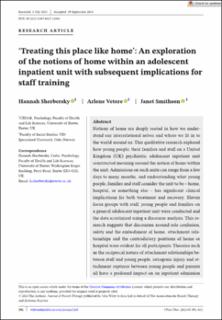| dc.contributor.author | Sherbersky, Hannah | |
| dc.contributor.author | Vetere, Arlene Louise | |
| dc.contributor.author | Smithson, Janet | |
| dc.date.accessioned | 2023-11-09T12:51:20Z | |
| dc.date.available | 2023-11-09T12:51:20Z | |
| dc.date.created | 2023-11-06T09:47:45Z | |
| dc.date.issued | 2023 | |
| dc.identifier.citation | Journal of Family Therapy. 2023, 45 (4), 392-413. | en_US |
| dc.identifier.issn | 0163-4445 | |
| dc.identifier.uri | https://hdl.handle.net/11250/3101663 | |
| dc.description | This is an open access article under the terms of the Creative Commons Attribution License, which permits use, distribution and reproduction in any medium, provided the original work is properly cited. | en_US |
| dc.description.abstract | Notions of home are deeply rooted in how we under stand our interrelational selves and where we fit in to the world around us. This qualitative research explored how young people, their families and staff on a United Kingdom (UK) psychiatric adolescent inpatient unit constructed meaning around the notion of home within the unit. Admissions on such units can range from a few days to many months, and understanding what young people, families and staff consider the unit to be – home, hospital, or something else – has significant clinical implications for both treatment and recovery. Eleven focus groups with staff, young people and families on a general adolescent inpatient unit were conducted and the data scrutinised using a discourse analysis. This re search suggests that discourses around role confusion, safety and the embodiment of home, attachment rela tionships and the contradictory positions of home or hospital were evident for all participants. Theories such as the reciprocal nature of attachment relationships be tween staff and young people, iatrogenic injury and at tachment ruptures between young people and parents all have a profound impact on an inpatient admissioand are often unspoken and under-operationalised. Clinical recommendations are made about the need for a paradigm shift in how admissions are understood for young people, how to manage the dilemmas associated with the unit becoming a home and what the subse quent training needs of inpatient staff are. | en_US |
| dc.language.iso | eng | en_US |
| dc.publisher | John Wiley & Sons | en_US |
| dc.rights | Navngivelse 4.0 Internasjonal | * |
| dc.rights.uri | http://creativecommons.org/licenses/by/4.0/deed.no | * |
| dc.subject | home | en_US |
| dc.subject | family therapy | en_US |
| dc.subject | discourse analysis | en_US |
| dc.subject | adolescent inpatient unit | en_US |
| dc.title | ‘Treating this place like home’: An exploration of the notions of home within an adolescent inpatient unit with subsequent implications for staff training | en_US |
| dc.type | Peer reviewed | en_US |
| dc.type | Journal article | en_US |
| dc.description.version | publishedVersion | en_US |
| dc.rights.holder | © 2023 The Authors. | en_US |
| dc.source.pagenumber | 392-413 | en_US |
| dc.source.volume | 45 | en_US |
| dc.source.journal | Journal of Family Therapy | en_US |
| dc.source.issue | 4 | en_US |
| dc.identifier.doi | 10.1111/1467-6427.12443 | |
| dc.identifier.cristin | 2192397 | |
| cristin.ispublished | true | |
| cristin.fulltext | original | |
| cristin.qualitycode | 1 | |

